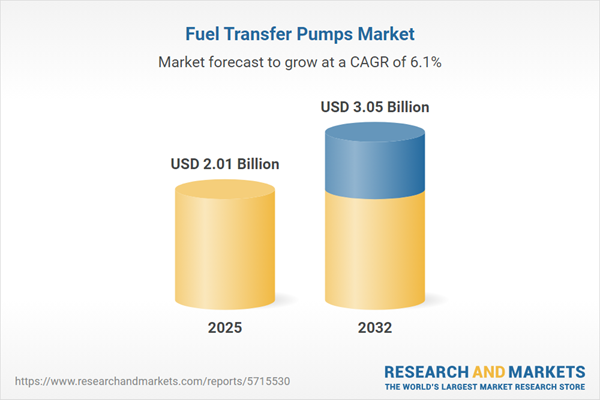Speak directly to the analyst to clarify any post sales queries you may have.
Senior decision-makers seeking competitive positioning in the fuel transfer pumps market face changing regulatory demands, heightened efficiency requirements, and ongoing digital transformation. Leveraging actionable market intelligence is essential for evaluating innovation opportunities, navigating region-specific compliance, and sustaining effective operations.
Market Snapshot: Fuel Transfer Pumps Market
The global fuel transfer pumps market holds a valuation of USD 1.89 billion in 2024, with ongoing participation from manufacturers, asset operators, and service providers accelerating sector growth. The anticipated increase to USD 2.01 billion by 2025, and projected expansion to USD 3.05 billion by 2032, support a compound annual growth rate (CAGR) of 6.13%. This trajectory reflects industry demand for operational excellence, longer equipment lifecycle, and complex regulatory compliance. Leading companies are deploying advanced pump technologies designed to boost fuel transfer reliability, support sustainability initiatives, and meet varying commercial and industrial requirements.
Scope & Segmentation
- Pump Types: Includes centrifugal, diaphragm, gear, piston, and rotary models, supporting both large-capacity transfers and precise delivery across multiple operation sizes.
- Fuel Types: Designed to accommodate aviation fuels, diesel, gasoline, and biofuels, aligning with industry moves towards alternative and blended sources.
- End Use Industries: Serves agriculture, automotive, manufacturing, marine, and petroleum, enabling modernization to address stricter standards and evolving process needs.
- Distribution Channels: Both OEM and aftermarket channels facilitate reliable lifecycle performance and mitigate installation risks across deployment types.
- Operation Modes: Electric, hydraulic, and manual configurations ensure continuity in networked and remote locations alike.
- Applications: Solutions address mobile and stationary requirements to ensure uninterrupted fuel delivery throughout transport, core infrastructure, and niche industrial uses.
- Flow Rate Classes: Options span from sub-100 to over 500 liters per minute, supporting a breadth of safety and operational capacities.
- Pressure Ratings: Ranges from low to high-pressure designs, enabling robust operation and durability based on unique site needs.
- Key Technologies: Features such as automatic shut-off, precision metering, Internet of Things (IoT) integration, and trigger controls increase measurement reliability and safety compliance.
- Regional Coverage: Strong activity in the Americas, Europe, Middle East, Africa, and Asia-Pacific, with adoption shaped by local regulations, supply chain dynamics, and operational imperatives.
- Companies Covered: Analysis includes Dover Fueling Solutions, Franklin Electric, Gorman-Rupp, Graco, Atlas Copco, Sulzer, ITT, IDEX, KSB SE, and Verder Pumpen, with emphasis on their innovation and differentiation strategies.
Key Takeaways for Senior Decision-Makers
- IoT-enabled and modular pump platforms improve maintenance practices and enable real-time visibility across distributed infrastructure estates.
- Adoption of advanced sensors, automated systems, and high-durability materials extends asset longevity and supports enterprise safety objectives.
- Cooperative approaches involving manufacturers, digital technology specialists, and service networks help align asset oversight and maintain business continuity.
- Strategic focus should adjust to regional demands; while some regions prioritize digital transformation, others emphasize strict compliance or maintain legacy upgrades.
- Aftermarket service agreements can preempt maintenance risks, enhancing operational reliability even in demanding environments.
Tariff Impact on Supply Chains and Costs
Ongoing adjustments in U.S. tariffs for pump components are influencing sourcing and production strategies within the market. These measures are prompting manufacturers and operators to diversify supply chains and consider more domestic manufacturing options to reduce vulnerability to international disruptions. The trend towards standardized composite pump designs is simplifying technical specification processes, while flexible contract models are now being adopted to help firms better manage costs and address the sophisticated needs of mature and developing markets.
Methodology & Data Sources
This market analysis draws on direct engagement with OEM executives, terminal operation managers, and aftermarket experts, complemented by technical workshops and thorough regulatory reviews. Insights from key industry associations are integrated to ensure that senior executives have reliable, balanced, and actionable guidance.
Why This Report Matters: Fuel Transfer Pumps Market
- Supports executive decision-making by identifying new pump technologies, detailing shifts in compliance, and revealing efficiency gains across sectors.
- Clarifies the effects of digitalization and regulatory change in shaping local and global market approaches, aiding tailored strategy development.
- Helps senior leaders strengthen risk management, refine investments, and adapt quickly to ongoing industry transformation.
Conclusion
This report delivers senior leaders with clear, practical guidance to optimize performance, sustain operational excellence, and respond with agility as market requirements and fuel transfer pump technologies progress.
Additional Product Information:
- Purchase of this report includes 1 year online access with quarterly updates.
- This report can be updated on request. Please contact our Customer Experience team using the Ask a Question widget on our website.
Table of Contents
3. Executive Summary
4. Market Overview
7. Cumulative Impact of Artificial Intelligence 2025
Companies Mentioned
The companies profiled in this Fuel Transfer Pumps market report include:- Dover Fueling Solutions, Inc.
- Franklin Electric Co., Inc.
- The Gorman-Rupp Company
- Graco Inc.
- Atlas Copco AB
- Sulzer Ltd
- ITT Inc.
- IDEX Corporation
- KSB SE & Co. KGaA
- Verder Pumpen GmbH
Table Information
| Report Attribute | Details |
|---|---|
| No. of Pages | 197 |
| Published | November 2025 |
| Forecast Period | 2025 - 2032 |
| Estimated Market Value ( USD | $ 2.01 Billion |
| Forecasted Market Value ( USD | $ 3.05 Billion |
| Compound Annual Growth Rate | 6.1% |
| Regions Covered | Global |
| No. of Companies Mentioned | 11 |









